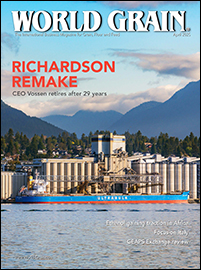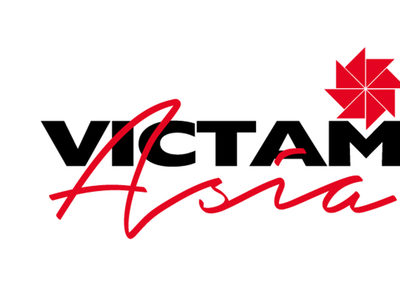Work systems are being pushed harder than ever, which means proper product design and material usage is critical for durability and longevity, said one supplier.
Equipment selection, layout and design, drying and storage capacity are all being centered on moving grain quickly. Customers are seeking efficient on-site traffic flow along with increased automation.
Customers also are looking for site-specific projects as a way to control costs and to ensure their facility best meets the demands of their environment and customers. They want innovative products that are more efficient and have greater value.
There is a growing need for more auxiliary equipment for drying, cleaning, grain handling and further processing. These trends require longer lead times due to additional site planning and installation.
Another global trend noted by multiple equipment suppliers is food safety and the reduction of food losses. This is driving the need for safe and effective grain storage. Manufacturers said they have an important role to play in providing such storage in order to reduce grain loss.
In some parts of the world, it’s not unusual to see 30% to 40% post-harvest losses. It’s estimated that one-third of food produced for human consumption is wasted. Even in developing markets where people are starving, food waste per capita is as high as 170 kilograms per year.
Good cleaning, gentle conveying, appropriate drying like storage aeration and cooling reduce post-harvest losses considerably, one supplier noted. Failure to dry crops adequately can lead to much higher levels of loss than poor-quality drying.
Poorly conceived ventilation of grain storage can result in further problems. If humid air is blown into dry grain in storage, for example, moisture will develop, building up significantly when the air temperature is higher than the grain temperature. Therefore, a well moderated airflow is important to extend storage time and hence market flexibility.
Different areas of the world are experiencing their own unique trends, such as in Australia, where a current major design element is for sealed fumigation grain storage. The nation is also experiencing expansion in its container packing facilities in order to utilize the large number of containers that leave the country for high demand in Southeast Asia.
The industry is moving forward despite considerable challenges in the last year. Market recessions in regions such as South America along with overcapacities in China and ongoing political challenges have led to cancellations of orders.
Sharp drops in raw material prices, such as rice and grain, also put a brake on investments, suppliers noted. Devaluation of the euro by some 10% has impacted suppliers’ cost base and competitiveness.
Commodity prices and currency fluctuations have created very conservative spending environments and habits for buyers. Some customers are taking a “wait-and-see” attitude due to the current economic climate.
In the U.S., the demand for new commercial grain projects has remained strong. There is some uncertainty associated with commodity prices and fluctuating currency prices, but there is also pressure to continue to meet needs and demands.
Company sees second expansion
Cameron Pastoral Company in Goondiwindi, Queensland, Australia, has seen its need to store more grain continue to grow over the last seven years. In 2009, the company contracted with Allied Grain Systems, an exclusive distributor in Australia of Global Industries, to provide four MFS 48-12 silos (capacity of 1,600 tonnes each) with a 12-inch Hutchinson grain pump system.
In 2015, Cameron again contracted with Allied for an additional four MFS S60-20 silos with a total capacity of 16,000 tonnes. The new silos are fully sealed to AS2628-2010 and include fumigation, recirculation systems as well as a comprehensive aeration system. The silos have external spiral stairs for easy access to the silo eaves, silo roof stairs and peak ring walk-arounds.
The project was a complete design, build and construction project where Allied Grain Systems designed and constructed the civil base along with the earthworks platform, the structural steel component and the grain conveying equipment. It took 25 weeks to complete.
Sealing of the silos and installation of the fumigation systems is a specialized and technical aspect of the overall project build. The quality of the Global Industries’ products and the skill and experience of Allied Grain Systems in the design and construction process allowed these systems to be completed on time and on budget with no operating issues since coming on line, Global said.
This system will allow the Cameron Pastoral Company to blend grain in all of its silos and to store grain for periods of up to 12 months in an insect-free environment, with temperatures internally controlled. Cameron handles sorghum, lupins, wheat, barley and chickpeas.
The conveyor system consists of a 270-tph Hutchinson commercial double chain 12-inch grain pump system around the four silos. The grain pump is fed via a Hutchinson chain and paddle drive-over hopper with remote operated lids. The silos also have internal silo sweep independent push tractors. The Hutchinson grain pump system has a number of advantages for this application, including: less electrical motors and drives; no expensive over-silo structural walkways; the ability to load and unload with the same system; the ability to blend gain from all silos together; and the ability to turn grain from partially empty silos into other silos.
Thai rice facility upgrades
Capital Chainat Rice Mill Co. Ltd., one of Thailand’s largest rice exporters, is continuing to upgrade and enhance its existing rice mills with new technology from Bühler AG, Uzwil Switzerland. The most recent project in Chainat, Thailand, took seven months to complete. The facility handles fresh harvest paddy and parboiled paddy.
The facility has three operational modes: 36% to 18.5% (parboil) with capacity of 56 tph for wet paddy and 41.7 tph for dry paddy; 30% to 14% (fresh harvest) with capacity of 51.6 tph for wet paddy and 42 tph for dry paddy; and 30% to 18% (maximize capacity during harvest) with capacity of 70 tph for wet paddy and 59 tph for dry paddy.
The project included six drum sieves AHCY 120; an 150-tph intake system; four 300-tonne wet bins; a three-pass drying line with three LEEA STKX6T-15/02 dryers; an AHKG chain conveyor; AHEL bucket elevator; and LiteCos control system and automation.
Cimbria supplies record order
Cimbria, based in Thisted, Denmark, is in the midst of supplying the biggest order in the company’s history – 23 grain silo plants with total storage capacity of 1.38 million tonnes and a value of more than $100 million – to Egypt. Financing of the project has been provided by the United Arab Emirates (UAE) to the government of Egypt, to support the development of the country.
Project design has been completed. Production of the many plants has been ongoing since spring 2015 and was completed in February. The complete shipment will eventually fill around 500 40-foot containers packed with equipment and another 800 containers with round steel silos. Delivery began in July 2015 and continued until early spring. Supervision of installation at most of the sites is in full progress following training and commissioning.
UAE and Egypt agreed that the Egyptian Engineering Authority of Armed Forces and the Administration of Military Works should select the main contractors and supervise the entire implementation. Cimbria was competing against companies from China, India, Turkey, the U.S., Canada, Germany and the United Kingdom for mechanical-electrical works.
Cimbria was selected and subsequently negotiated sub-contracts with contractors for 15 plants, Petrojet for four plants, Samcrete for two plants and Misr Concrete Development Co. for the last two plants.
The order includes project design and engineering, supply of conveying equipment, cleaners, dust filter systems, weighing equipment, laboratory equipment, silos, electronic control systems featuring SCADA/PLC, inventory recording systems with scanners in each silo, sufficient spare parts for three years of operation and delivery to Egypt. The project also includes supervision of the equipment, silos and electrical systems at the 23 facilities. Following installation, Cimbria will embark on a training program in which 20 Egyptian employees at each plant will receive instruction in operation and maintenance. Final capacity testing will also be performed prior to handing over the many new plants.
Each of the 23 plants has a silo capacity of 60,000 tonnes, including conveying and cleaning facilities with a capacity of 200 tph. Total silo capacity will amount to 1.38 million tonnes. The locations of the 23 plants stretch from the Mediterranean Sea and Suez all the way down to Aswan, in addition to a plant west of Aswan.
Egypt has a high consumption of grain, is a leading importer of wheat and has an annual import of 17 million tonnes of different grain products. Local production takes place on 4% of Egypt’s rural land, corresponding to a total production of 23 million tonnes of a range of different grain products.
Of the 23 plants being delivered, Cimbria will be supplying 12 facilities for The Egyptian Holding Company for Silo Storage under the Ministry of Supply & Home Trade, which will primarily be used as a buffer and intermediate storage facilities for imported wheat. Ten facilities will be erected for the Principal Bank for Development & Agricultural Credit under the Ministry of Agriculture and Land Reclamation at various locations throughout the country, to which farmers can sell and deliver locally produced grain.
Currently, a substantial part of the grain received by the Ministry of Agriculture is stored outdoors, which results in enormous losses. The new silos will replace such open bag storage facilities. The final facility is to be delivered to North Cairo Flour Mills Co.
GSI supplies train loading facility
GSI, Assumption, Illinois, U.S., recently provided equipment for a greenfield project by Arthur Companies in Pillsbury, North Dakota, U.S.
The train loading, grain drying and storage facility handles corn, soybeans and wheat along with smaller quantities of specialty crops. EEE, Inc. constructed the facility in 15 months, and the first shipment was received in May.
The GSI equipment included six 72-foot, 30-ring storage tanks with GSI X-Series sweeps; six GSI 24-foot hopper tanks; a Zimmerman Z-7000 commercial tower dryer; GSI belt conveyors; GSI drag chain conveyors; GSI bucket elevators; and Intersystems truck probe.
Sweet assists Mexican cooperative
Located in northwestern Mexico, Semillas Seleccionadas del Yaqui, also known as UCAY Cooperative, wants to become an all-inclusive supply chain operation from seed, to fertilizer, to harvested crop. The facility handles wheat seed, harvested wheat and corn.
With that in mind, the agricultural cooperative recently added 53,000 tonnes of storage that required material handling equipment supplied by Sweet Manufacturing Co., Springfield, Ohio, U.S., to fully capitalize on the expansion.
Sweet partnered with OCESA, a Sweet authorized representative in Mexico who sold this project and installed the equipment. Included was equipment to handle and process wheat seeds at 80 tph and harvested wheat and corn at 250 tph.
The expansion included four Silver-Sweet bucket elevators (three Ace II models and one Apollo II model), 1,320 feet of Flite-Veyor 12 and 17 series horizontal flat bottom conveyors (1012, 1417 and 1817 models), and 515 feet of Silver Span catwalk.
OCESA has installed multiple pieces of handling and storage equipment at the UCAY facilities and maintains a close working relationship with its owners and operators.
Altuntas provides storage for three sites in Turkey
Altunta? Group, based in Aksaray, Turkey, and Kayseri ?eker Fabrikas? A.?. signed a license storage agreement last year for storage projects in three provinces in Turkey. Work started on the projects in September 2015 and is expected to be complete this summer.
Projects included:
• 40,000-tonne flat-bottom (conical concrete) steel silo facility in Bo?azl?yan, Yozgat.
• 20,000-tonne hopper bottom steel silo facility in Develi, Kayseri.
• 20,000-tonne hopper bottom steel silo facility in ?ark??la, Sivas.
The facilities were designed and built by Altuntas. The projects are turnkey and feature fully automated systems. Various grains such as wheat, corn and barley will be stored at the facilities.
State-of-the-art port terminal
Two years ago, Noble Group and Ukrbud set out to build a state-of-the-art port terminal in the Mykolayiv region of Ukraine to act as a main collection and transfer point for the area’s agriculture industry. Located at the mouth of the Pivdennyi Buh River, the terminal’s construction was spearheaded by Ukrbud President Vasyl Kapatsyna and Director Andriy Dmytrenko.
As construction neared completion this year, the facility was sold to COFCO, the Chinese state-owned food processing holding company. COFCO completed its purchase of Noble Agri Limited in March and renamed the business COFCO Agri Ltd.
The Mykolaiv grain port terminal, which has a transshipment capacity of 2.5 million tonnes per year, will now function as a primary export location to China. The site has ultra-high-speed handling capabilities along with value-added services such as drying, cleaning and blending. Cereals and corn are handled at the terminal.
Ag Growth International (AGI), based in Winnipeg, Manitoba, Canada, was a major supplier to the project. Several of its commercial products are in use at the facility including: Union Iron bucket elevators, Tramco and Union Iron chain conveyors, Hi Roller belt conveyors, AGI/Twister storage bins and Airlanco aeration fans.
With handling capacities of up to 1,000 tph and 1.6 million tonnes per year, the Union Iron, Tramco and Hi Roller conveyors allow grains and cereals to be moved quickly from the in-loading to the out-loading sites.
Another notable aspect of the terminal is its storage and drying capacities, AGI said. AGI’s 16 Twister bins located at the port have holding capacities of 8,000 tonnes each. Additionally, AGI’s Airlanco aeration fans have drying capabilities up to 150 tph.
Djibuti gets first grain facility
The United Nations’ World Food Program is constructing its first storage plant for wheat on Djibuti, in the horn of Africa. This will also be the first storage plant in the nation, which previously has transported wheat in sacks.
Mulmix SpA, based in Campo San Martino, Italy, was awarded the project in 2015 including the design and construction. The plant, which is now being assembled, will be a storage and sorting center for all the cereals (wheat, maize, sorghum and rice) coming in at the port of Djibuti.
With four automatic bagging lines, the grain will be bagged in sacks of 50 kilograms each and transported by road to countries with financial difficulties, war, plague and famine situations. The project was designed in cooperation with the customer in six months, produced in four months and will be assembled in about nine months.
Mulmix supplied four receiving pits for cereals that can be used either individually or at the same time; four flat-bottomed storage silos; and one building in which there are four automatic bagging lines with a capacity of about 800 sacks per hour, fed by a buffer silo. It also supplied bucket elevators, chain conveyors, magnetic separator, trellis and Reticolar catwalk.
In addition, the World Food Program has conceived a logistics hub to coordinate the reception and shipping of materials, a training center for on-site personnel, two storage warehouses of which one will be used for temperature-controlled storage of perishable products.
The plant has been designed to operate 24 hours a day, 365 days per year. It is equipped with a double loading line with two independent bucket elevators and a double line of Redler chain conveyors with mechanical, electrical and software independent management.
This makes it possible to unload ships in the shortest time possible, especially in the case of calamity or problems on the power supply, Mulmix said. Energy-savings was an important part of the design, with the use of LED lighting and efficient mechanization to reduce the consumption of electrical power.
Mulmix took care of the project’s civil works and metallic carpentries, but also of the power center, switchboards, as well as the lighting system, services and development of the management and control software.
The software permits the continuous monitoring of the main data including the amount of grain stored; the number of filled sacks; the temperature of stored products; the hours of operation of the plant; the power absorption; and the number of starts.
Kazakhstan port adds capacity
Silos Cordoba, based in Cordoba, Spain, recently completed work for a maize (corn) storage facility at Port of Aktau in Kazakhstan. The facility provides storage and handling for bulk carriers. Collection of corn at the facility is by train.
Total capacity is 82,650 tonnes for the storage of 62,000 tonnes of cereal. Silos Cordoba supplied six falt silos model 27.50/18 with a capacity of 13,760 tonnes each.
The facility can be divided into three main areas of work: reception of cereals at 500 tph; storage of cereals; and dispatch of cereals from silos to ships at 500 tph via a ship loader. It also has a dust aspiration system at intake pit and handling equipment; a pre-cleaner system; an electrical panel with PLC and SCADA; a lightning system; a fire extinguishing system; water drainage and a weighing system that uses a continuous flow scale of 500 tph.
Feed mill adds to grain storage
When Mexico’s largest egg producer needed to increase its grain storage capacity, it turned to Gonbar Construction, Guadalajara, Mexico and Behlen Manufacturing Co., Columbus, Nebraska, U.S., companies that it worked with in the past on multiple projects.
Proteina Animal, S.A. DE C.V. (PROAN), located in San Juan de los Lagos, Jalisco, Mexico, increased the storage capacity at its feed mill by 180,000 tonnes. Gonbar, a Behlen dealer, was the contractor for the project.
The project took seven months to complete from the day the order was taken in May 2015 to when the last silo was filled on Dec. 31, 2015. The facility handles corn and milo.
The expansion included 10 silos model 32x25 with a diameter of 32 meters and an eave height of 25 meters. Each bin has a capacity of 18,000 tonnes for a total capacity of 180,000 tonnes. The silos included aeration and temperature monitoring cables.
In 2010, Behlen supplied PROAN with equipment for a shuttle train receiving facility including six silos with a capacity of 12,000 tonnes each, for total capacity of 72,000 tonnes. This included Hi Roller conveyors with a capacity of 1,000 tph.
Company adds identical facilities
Maxei recently added two greenfield commercial storage facilities with pre-cleaning in Salvatierra and Acambaro, Mexico, for the storage and handling of corn, sorghum and barley. It took about six months for Superior Grain Equipment, based in Kindred, North Dakota, U.S., to complete work on the two identical sites.
Superior constructed two 7512 commercial stiffened bins at the two sites. Each bin has the capacity to hold 5,100 tonnes. The bins feature multi-panel structured roofs with a standard 30,000-pound peak load. Upper roof sheet z-brackets support the upper roof sheet for added strength and rigidity.
Galvanized x-bracing between purlins provides for secure alignment of rafters and roof sheets. Tension purlins stabilize both the roof and sidewall sheets in order to eliminate distortion.
A complete Herculok heavy-duty full floor aeration system with two 20-hp low-speed centrifugal fans and a commercial bin sweep was installed. A multiple temperature cable monitoring system was also installed to provide accurate information on changing grain conditions in the bin.
Each bin also included a galvanized overhead catwalk system with fill conveyors, bucket elevators, support towers and pre-cleaners. Both sites were designed with tipper scales for weighing and off-loading trucks.
Future expansion at both sites will include additional 7512 commercial bins and Excel Grain Dryers manufactured by Superior. These projects were the first time Superior worked with Maxei, which is also a Superior dealer.
Uruguay greenfield facility
Lambton Conveyor, Wallaceburg, Ontario, Canada, recently completed work at 40,000-tonne grain storage facility in Carmelo, Uruguay. The greenfield project took a year to complete and was fully designed and supplied with Lambton silos, hoppers, support systems, handling equipment and accessories. The facility handles soybeans and corn.
Equipment supplied by Lambton included: a 200-tph 20x20 receiving drag conveyor; transfer drag, 200-tph silo loading day conveyors; two additional silo loading drag conveyors; silo reclaim transfer drag conveyors; 600-tonne silo reclaim drag conveyor, 20x20 at 200 tph; transfer drag from dryer, 20x20 at 200 tph; 12x17 200-tph truck loadout drag conveyor; receiving bucket elevator; 155 feet of 200 tph, 36-inch 12x8 loading and reclaim bucket elevator; 155 feet of 200 tph, 36-inch 12x8 loading/reclaim bucket elevator; eight 500-tonne 750-foot, 12-ring flat bottom silos; two 600-tonne, 27-foot hopper bottom silos; one 12-foot, 6-ring truck loadout hopper bottom silo; supports and catwalks; and spouting, distributors and valve options.
Mexican facility doubles capacity
In just two years’ time, Flesgran has doubled the storage capacity at its facility in Los Mochis, Sinaloa, Mexico, making it one of the largest storage facilities in the country. Sukup Manufacturing Company, based in Sheffield, Iowa, U.S., supplied equipment for the original 20,000-tonne facility built two years ago, and the recent 20,000-tonne expansion.
The project took three months to complete. Flesgran handles corn and sorghum at the facility.
Sukup supplied 105-foot-diameter, 12-ring bins; 75-foot-diameter, 12-ring bins; 30-foot-diameter 8-ring bins; a 150-tph receiving pit; a 300-tph unloading system; bucket elevators and drag conveyors; and a triple stack grain dryer.
Iowa cooperative adds to storage
In the last five years, Gold-Eagle Cooperative has added nearly 14 million bushels of grain storage. Its most recent greenfield project was in Wesley, Iowa, U.S., where Brock Grain Systems, Milford, Indiana, U.S., supplied storage bins, a dryer and portions of the towers and catwalks. The facility primarily handles corn.
The newest addition took 6 to 7 months to complete. The additional storage included two Brock Everest grain storage bins with a diameter of 105 feet and capacity of 750,000 bushels of corn and one Everest grain storage bin with a diameter of 72 feet and capacity of 280,000 bushels of corn.
Brock also supplied a commercial tower dryer with a drying capacity of up to 4,700 bushels per hour for drying wet corn from 20% down to 15% moisture. A significant amount of Brock structures were also part of the towers and catwalks.
New bins for Mexican facility
Chief Industries Inc., Kearney, Nebraska, U.S., recently completed a project for Lala-Nuplen in Torreon, Mexico. The general contractor for the project was Meprosa, SA de CV.
Chief supplied four 105-foot diameter bins that are 36 meters high. Total storage capacity is 96,096 cubic meters. The project also included Chief CBEG48 bucket elevators with a capacity of 1,200 tph with 400 hp and a discharge height of 155 feet. The facility has Hi-Roller belt conveyors with a capacity of 1,200 tph.








